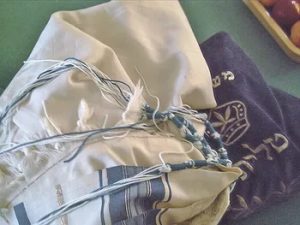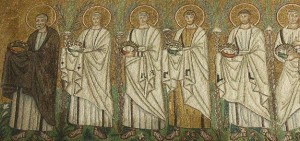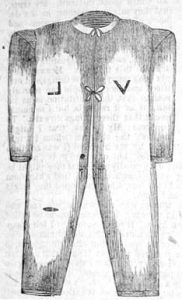Temple Garments: A History and Explanation
Sacred temple clothing worn by Latter-day Saints (including “garments”) exists as part of a larger landscape of holy vestments.
When Moses was first instructed on true temple worship, he was told what specific clothes Aaron’s descendants should wear, with additional clothes set apart for the high priest (Exodus 28). Each article of the holy clothing served as a reminder of the priest’s duty and the righteous standard to which he must adhere to officiate in his office (Ex 28:36-38). Before Moses, Israel gave his son Joseph a coat specially marked to show his favor (Genesis 37:3). This coat became a pattern for Captain Moroni to mark his own coat in token of a national covenant (Alma 46:11-27). Even earlier than all this, Adam’s coat of skins (Gen 3:21) shows up repeatedly in tradition associated with covenantal birthright (The Book of Jasher 7 & 27).
 Jewish men at the time of Christ wore five articles of clothing: a headdress, shoes, inner garment, outer garment, and girdle (Doctrinal New Testament Commentary 1:820). These articles were augmented according to the Mosaic covenant passed to Israel. They wore little blue fringes on the hem reminding them to observe strict obedience to the commandments they were given (Numbers 15:37-40).
Jewish men at the time of Christ wore five articles of clothing: a headdress, shoes, inner garment, outer garment, and girdle (Doctrinal New Testament Commentary 1:820). These articles were augmented according to the Mosaic covenant passed to Israel. They wore little blue fringes on the hem reminding them to observe strict obedience to the commandments they were given (Numbers 15:37-40).
Additionally, some Jews and early Christians from this period and a little later marked their garments with capital rhos and gammas (Greek R and G), as seen in the image I’ve included. I have personally seen one such cloth augmented with this so-called gammadia from a Masada excavation. The purpose of these markings was not well documented, but some scholars currently speculate that they have a religious or ritual significance.

We’ve been taught in modern days that wearing the garment is an outward expression of an inner commitment. The garment is a symbol and reminder of our covenants much like a wedding ring. The rings we exchange are an outward witness of an inner commitment to our spouse. Similarly, garments are a symbol of the covenants we have made with God. This commitment is personal; it’s between us and God, not for the world. Thus garments are worn next to the skin, not outwardly for show. Each time we put on the garment it is as if we are reaffirming that we remember and will keep the covenants we have made.
How we treat our garments is in similitude of how we think, respect, and revere the sacredness of our covenants. I’ve always been told to never leave your garments on the floor, for example. It shows a carelessness and disrespect for the covenants we make in the House of the Lord.
Elder Nelson, then of the Quorum of the Twelve wrote an excellent article entitled, “Personal Preparation for Temple Blessings.” It appeared in the July 2001 Liahona. In it he states:
“Wearing the temple garment has deep symbolic significance. It represents a continuing commitment. Just as the Savior exemplified the need to endure to the end, we wear the garment faithfully as part of the enduring armor of God. Thus we demonstrate our faith in Him and in His eternal covenants with us.”
The Temple garment serves three important purposes: it is a reminder of the sacred covenants made with the Lord in His holy house, a protective covering for the body, and a symbol of the modesty of dress and living that should characterize the lives of all the humble followers of Christ.
We are encouraged to wear them at all times. We should always seek reasons to wear them, than to not wear them. Consistent wearing of the garment helps us to “put on the whole armor of God”.
One of our modern apostles, Boyd K. Packer, has written about the garment to prepare members to worship in the temple.
“The garment represents sacred covenants. It fosters modesty and becomes a shield and a protection to the wearer” (Boyd K. Packer, The Holy Temple, p. 75-79).
The notion that the garment “becomes a shield and a protection” is where outsiders have taken to calling it “magic underwear.” We do not view it as such, and Elder Packer even goes on to explain.
“The garment, covering the body, is a visual and tactile reminder of these covenants. For many Church members the garment has formed a barrier of protection when the wearer has been faced with temptation. Among other things it symbolizes our deep respect for the laws of God — among them the moral standard” (ibid.)
The original garment had four marks that were snipped into the cloth as part of the original Nauvoo endowment ceremony. These marks were a reverse-L-shaped symbol on the right breast, a V-shaped symbol on the left breast, and horizontal marks at the navel and over the right knee. These cuts were later replaced by embroidered or screen-printed symbols.

The marks in the garments are sacred symbols. Thus, the V-shaped symbol on the left breast was referred to as “The Compasses”, while the reverse-L-shaped symbol on the right breast was referred to by early church leaders as “The Square”.]
According to a description by church president John Taylor in 1883, the “Square” represents “the justice and fairness of our Heavenly Father, that we will receive all the good that is coming to us or all that we earn, on a square deal”, and the “Compasses” represents “the North Star”. In addition to the Square and Compasses, Taylordescribed the other symbols as follows: the collar represented the idea that the Lord’s “yoke is easy and [his] burden is light”, or the “Crown of the Priesthood”; the double-knotted strings represented “the Trinity” and “the marriage covenant”; the navel mark represents “strength in the navel and marrow in the bones”; and the knee mark represents “that every knee shall bow and every tongue confess that Jesus is the Christ”.
In 1926, LDS Church apostle David O. McKay offered an updated description that was later incorporated into the church’s endowment ceremony. According to McKay’s explanation, the “mark of the Compass” represents “an undeviating course leading to eternal life; a constant reminder that desires, appetites, and passions are to be kept within the bounds the Lord has set; and that all truth may be circumscribed into one great whole”; the “mark of the Square” represents “exactness and honor” in keeping the commandments and covenants of God; the navel mark represents “the need of constant nourishment to body and spirit”; and the “knee mark” represents “that every knee shall bow and every tongue shall confess that Jesus is the Christ”.] Unlike Taylor, McKay did not describe the symbolism of the collar or the tie-strings because those elements of the garment had been eliminated in 1922. (Wikipedia)


